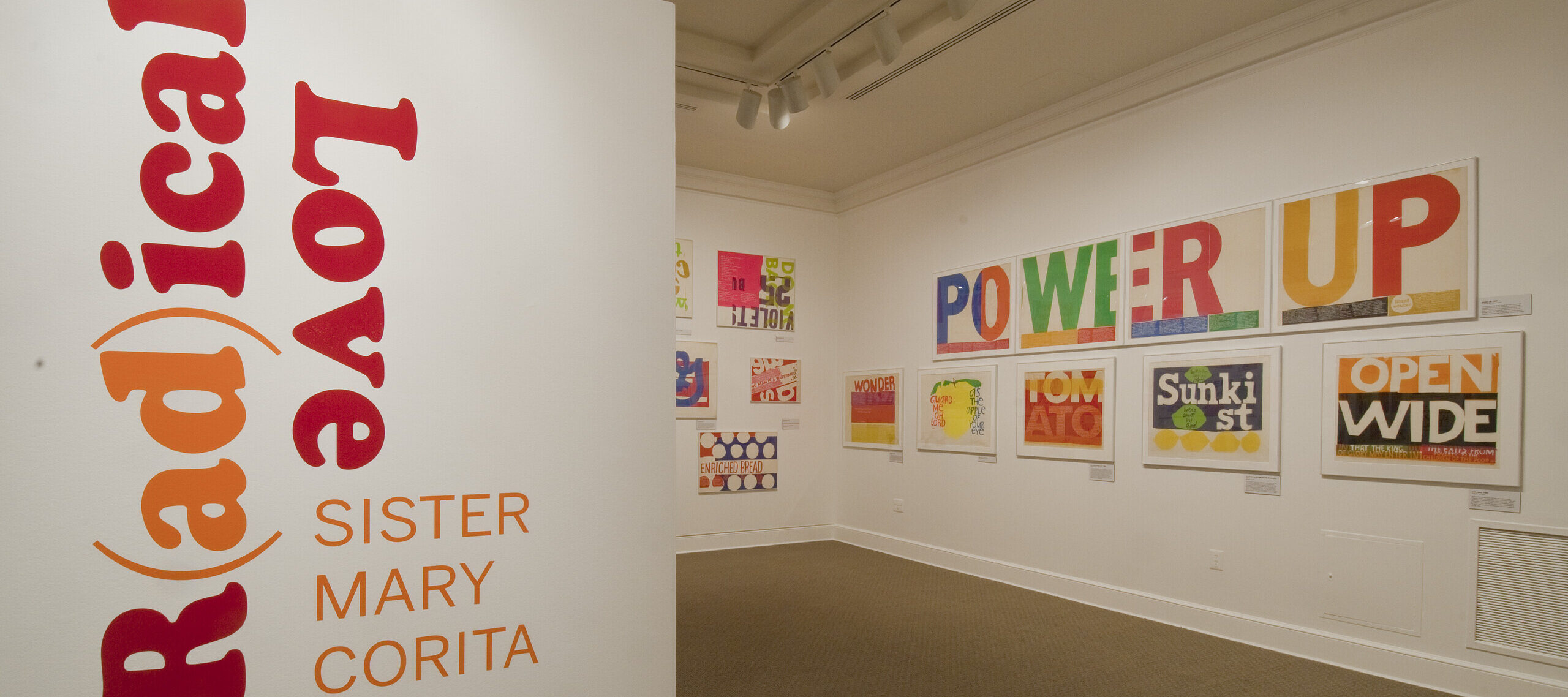“Productive.” “Energetic.” “Joyous.” “Selfless.” “Creative.”
These words have often been used to describe Sister Mary Corita (later Corita Kent, 1918–1986). A deeply spiritual woman, she used art as a platform to display her messages of love, happiness, and God. Her artistic mission was to seek joy and beauty in ugly places, like everyday consumer slogans; however, she was also influenced by her religion, politics, and other artists, especially the ones who “made the most noise.”¹ According to her close friend, Reverend Robert Giguere, of the Society of Saint Sulpice, Sister Mary Corita struggled to strike a balance between her art and her religious practice. However, her two roles fed each other, and although she later left the sisterhood, she said, “I probably would never have taken up art seriously if I hadn’t become a nun.”² Her vibrant voice and artwork can be witnessed now at NMWA in R(ad)ical Love: Sister Mary Corita, on view through July 15.

Corita developed into a 1960s pop-art style artist gradually. When she joined the art department at the Immaculate Heart of Mary College (IHC) in Los Angeles in 1949, she began spending summers creating silk-screen prints. She initially chose to produce works with strictly religious themes, but by the 1950s, she had branched out to include more political themes. She addressed the Vietnam War, supported the Civil Rights Movement, advocated for Cesar Chavez, and quoted presidents and poets in her colorful serigraphs.³ She used excerpts from the work of poets who inspired her, like Gertrude Stein and E. E. Cummings, making her work as accessible as possible to the public. Her message was modern as well as universal, and her efforts to reach a broad audience were also reflected in her evolving style. In the 1960s, she began incorporating text-based slogans borrowed from consumer products, which enlivened her silk-screen prints, aligned her with the Californian avant-garde aesthetic, and gave her works a new meaning.

Corita’s work urged viewers to look at phrases like “Meatballs make you sing,” and read them as psalms expressing religious views or praising God. Her work was defined by her ability to transform mass production into a new entity with spiritual and social meaning. Corita’s philosophy was that everyone could be an artist and that it takes only an eye for beauty to discern art. To her, art was as simple and biological as eating. It did not have to be complicated or dark, as other artists made it out to be. “There is a myth around that artists suffer a painful and lonely task in their making…And of course the myth is true if we acknowledge that every human being is an artist…that pain and loneliness and making is in each of us…not only in those who paint or dance or make music. But there are joyful times, too and the artist is never alone actually in that everyone else is going thru same process…each with her own unique sound…So we are really all in it together and there are no people who are not artists.”⁴ Evidence of her optimistic view toward art is her favorite serigraph, daisy. In hot pink, red, and purple, the flower’s petals are formed out of the repeated word “Yes,” an expression of her embrace of life and art.
Notes:
1. The quote included here was taken from Vincent Lanier, “An Interview with Sister Mary Corita,” from Art Education (1965), Volume 18, No. 2.
2. The quote included here was taken from “The Nun: A Joyous Revolution.” Newsweek, 25 December 1967.
3. The biographical information included here is based on Jeffrey M. Burns, “Be of Love (a Little) More Careful: Sister Corita, Father Bob, Love, and Art,” from the U.S. Catholic Historian (2001), Volume 19, No. 3.
4. The quote included here was taken from the Corita Papers, 1936-1992; MC 583, #5.3, from the Schlesinger Library, Radcliffe Institute, Harvard University, Cambridge, Mass.
